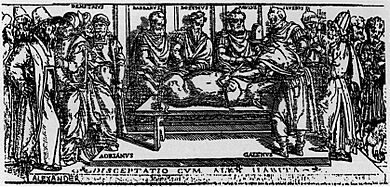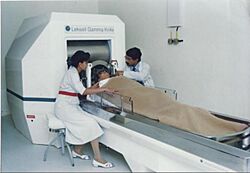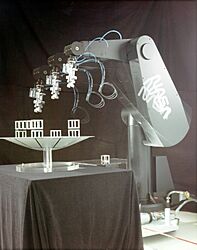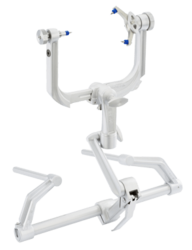History of neurology and neurosurgery facts for kids
The study of the brain and nervous system has a long and fascinating history! Neurology is the medical field focused on understanding and treating problems with the nervous system, which includes your brain, spinal cord, and all the nerves in your body. Neurosurgery is the special type of surgery performed on these delicate parts. While people have been observing and trying to treat brain injuries for thousands of years, these medical fields really started to grow and become organized in the 20th century.
Contents
Early Discoveries in Brain Science
Ancient Times: First Brain Operations
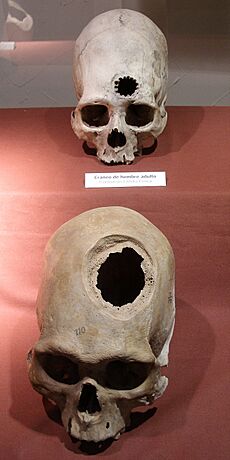
One of the oldest known surgeries is called trepanning. This involves making a hole in the skull. People in the Stone Age did this in many parts of the world. Archaeologists have found cave paintings and ancient skulls showing this practice. For example, a third of 120 skulls found in France from 6500 BCE had been trepanned!
The Inca people in South America were also very skilled at trepanning. Early methods often led to death, but by the 1400s, Inca surgeons were so good that about 90% of patients survived! They learned to avoid dangerous areas of the head and used a scraping method that caused less harm. They likely used special herbs to help with healing too.
Ancient Egypt and Beyond
The ancient Egyptians also studied injuries. An old Egyptian text called the Edwin Smith papyrus describes brain injuries. It even mentions parts of the brain like the meninges (the coverings of the brain) and cerebrospinal fluid (the liquid around the brain). The Egyptians noticed that brain injuries could affect other body functions.
Other ancient cultures also observed neurological problems. The Sumerians, for example, showed paraplegia (paralysis of the lower body) caused by an injury in a stone carving. Even Buddha's physician, Jīvaka Komārabhacca, is said to have performed brain surgery to remove parasites in the 5th century BCE.
The ancient Greeks also made important observations. The famous physician Hippocrates believed that epilepsy had a natural cause, not a magical one. Aristotle described the brain's coverings and different parts like the cerebrum and cerebellum.
Later, in Rome, Galen studied the nervous system by dissecting animals. He famously discovered the importance of the recurrent laryngeal nerves. He accidentally cut these nerves in a squealing pig, and the pig immediately stopped squealing but kept moving! He repeated this experiment on many animals and even showed it to a large audience in Rome.
In ancient China, the physician Hua Tuo was known for performing neurosurgical procedures. In the Islamic world, Al-Zahrawi (from 936 to 1013 AD) treated head injuries, skull fractures, and spinal injuries. Around the same time, Avicenna in Persia also wrote in detail about skull fractures and their surgical treatments.
Understanding Brain Anatomy and Function
The Renaissance: New Views of the Brain
After the ancient Greeks, real progress in neurology and neurosurgery picked up again during the Renaissance. The invention of the printing press helped spread knowledge. Early books, like Compendium philosophiae naturalis (1499), showed drawings of the brain's coverings and fluid-filled spaces called ventricles.
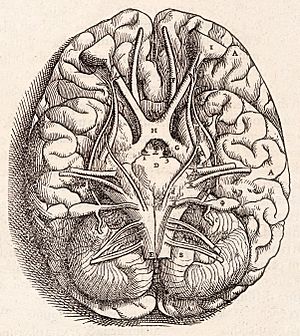
A huge step forward happened in 1543 when Andreas Vesalius published his book, De humani corporis fabrica. It had very detailed pictures of the brain, including the cranial nerves, pituitary gland, and blood supply. Vesalius disagreed with the common idea that the brain's ventricles were responsible for thinking. He pointed out that many animals have similar ventricles but aren't as intelligent as humans.
In 1549, Jason Pratensis wrote a book just about neurological diseases. Later, in the 1660s, Thomas Willis published important works on the brain. He was one of the first to remove the brain from the skull to study it better. He described the "circle of Willis," a network of blood vessels that supplies the brain. He also had early ideas about how different parts of the brain might control different functions and was one of the first to use the word "neurology."
Seeing Disease and Electricity
Doctors began to understand diseases better by studying affected body parts after death. Matthew Baillie and Jean Cruveilhier drew pictures of the damage caused by stroke in the late 1700s and early 1800s.
The philosopher René Descartes thought that animal actions were reactions to outside signals, with nerves connecting the signal to the response. In 1718, Isaac Newton suggested that the brain sent signals to muscles through nerves.
In the late 1700s, Luigi Galvani showed that electrical signals could make muscles contract. Later, Charles Bell and François Magendie discovered that different parts of the spinal cord controlled movement and feeling.
Microscopes and Brain Mapping
It wasn't until microscopes improved that scientists could see tiny brain cells. In 1837, J.E. Purkinje was one of the first to describe neurons, which are the basic cells of the nervous system. By 1850, Helmholtz could even measure how fast signals traveled along a frog's nerve!
Later, Golgi and Cajal developed ways to stain nerve cells, showing their complex branches. They realized that these cells touched each other at tiny gaps called synapses.
Even though the brain's structure was becoming clearer, its functions were still a mystery. Paul Broca discovered that a specific area of the brain was linked to speech after studying a patient who couldn't speak. This showed that certain brain functions are located in specific areas. Ivan Pavlov observed that dogs could be trained to drool at a signal, showing how simple reflexes could be changed by higher brain functions. These ideas were brought together by neurophysiologist Charles Scott Sherrington.
Tools for Diagnosis
In the 19th century, doctors started to specialize in neurology. Important figures included Moritz Heinrich Romberg and Jean-Martin Charcot. To help patients, doctors needed special tools. Over time, they developed instruments like the tendon hammer (to check reflexes), the ophthalmoscope (to look into the eye), and the tuning fork (to test feeling). They also learned how to perform a lumbar puncture (spinal tap) to collect fluid from around the spinal cord.
Later, amazing technologies like X rays, electro-encephalography (EEG, which measures brain waves), angiography (to see blood vessels), myelography (to see the spinal cord), and CAT scans (detailed X-ray images) were invented. These tools allowed doctors to see inside the body and diagnose problems without surgery. Doctors could then compare what they found in living patients with what they saw after death, helping them understand diseases better.
By the end of the 1800s, doctors had connected problems like stroke to paralysis on one side of the body, and injuries to paralysis of the lower body.
Modern Neurosurgery
Advances in Brain Surgery
Neurosurgery made huge leaps forward in the late 19th and early 20th centuries. This is when doctors started placing electrodes on the brain and removing tumors from the brain's surface.
Electrodes in the Brain: In 1878, Richard Caton found that electrical signals traveled through an animal's brain. In 1950, Dr. Jose Delgado invented the first electrode implanted in an animal's brain, using it to control its movements. In 1972, the cochlear implant became available. This amazing device allows deaf people to hear by stimulating the nerves in the ear. In 1998, Philip Kennedy implanted the first brain–computer interface (BCI) into a human. This allowed the person to control a computer with their thoughts!
Removing Tumors: In 1879, Scottish surgeon William Macewen successfully removed a brain tumor. He found its location just by observing the patient's symptoms. A few years later, in 1884, English surgeon Rickman Godlee performed the first removal of a primary brain tumor after it was located by physician Alexander Hughes Bennett.
In 1887, Victor Horsley was the first doctor to remove a spinal tumour. In 1907, Austrian surgeon Hermann Schloffer successfully removed a pituitary tumor. American surgeon Harvey Cushing also successfully removed a pituitary tumor in 1909. These surgeries were major achievements because they could treat problems caused by glands that produce too many hormones.
A procedure called leucotomy (now known as lobotomy) was developed by Egas Moniz in Portugal to treat severe mental disorders. While it's sometimes linked to the famous case of Phineas Gage (a railroad worker who survived a severe brain injury), the evidence suggests this wasn't the direct inspiration for the procedure.
Modern Surgical Tools
- Modern neurosurgical instruments
Many of the big improvements in neurosurgery came from having better tools. Modern neurosurgical tools include tiny chisels, curettes, and forceps. While some of these tools have been around for a long time, the main difference today is their incredible precision. They are made with edges that are accurate to within a millimeter! Newer tools like handheld power saws and robots are also now commonly used in brain surgery.
See also
 In Spanish: Historia de la Neurología para niños
In Spanish: Historia de la Neurología para niños
- History of neuraxial anesthesia
- History of neuroscience
- History of neuropsychology
- History of psychology
- History of psychiatry
- History of neurophysiology
- List of neurologists and neurosurgeons


